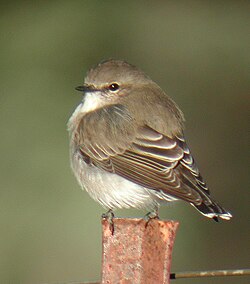| Microeca | |
|---|---|
 | |
| Jacky winter (Microeca fascinans) | |
| Scientific classification | |
| Kingdom: | Animalia |
| Phylum: | Chordata |
| Class: | Aves |
| Order: | Passeriformes |
| Family: | Petroicidae |
| Genus: | Microeca Gould, 1841 |
| Type species | |
| Microeca assimilis [1] Gould, 1841 | |
| Species | |
see text | |
Microeca is a genus of passerine birds in the Australasian robin family Petroicidae. The species in this genus are commonly known as flyrobins (along with the closely related torrent flyrobin).

